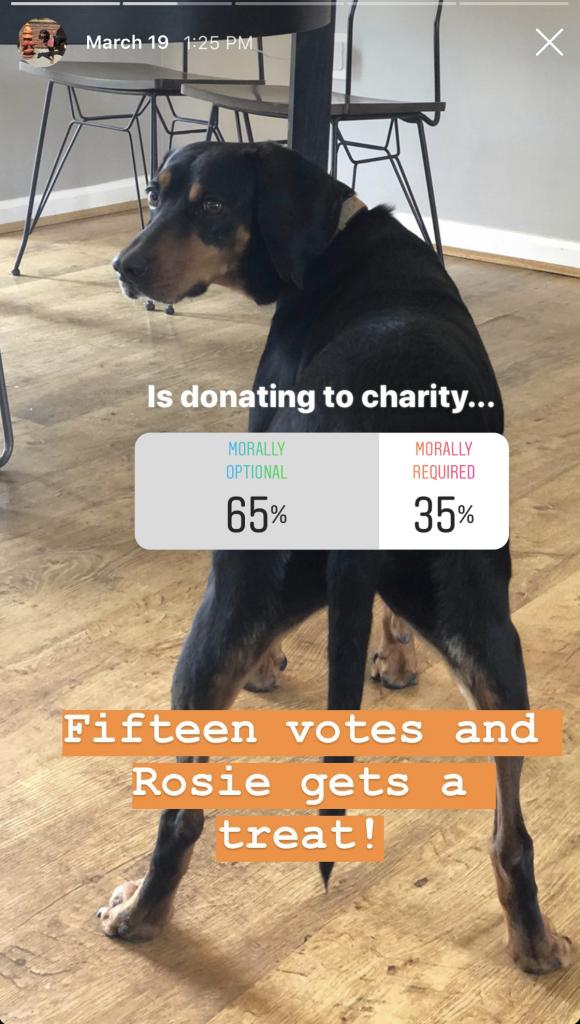The Pawfessor Is In (guest post by Jordan MacKenzie)
The following is a guest post* by Jordan MacKenzie, assistant professor of philosophy at Virginia Tech, in which she shares some of her strategies for sucessfully moving courses online.
The Pawfessor Is In
by Jordan MacKenzie
The last two weeks have brought about an unprecedented teaching challenge, as educators everywhere struggle to adjust to their new positions at ‘Zoom University’. Like many readers of this blog, I had very little familiarity with online teaching prior to the pandemic. But now that my lectures for the week have been recorded, my syllabi pared down, and my classes made ‘asynchronous’, I can now say one thing with confidence:
Instagram is a pedagogical godsend that we should all embrace even once this pandemic has subsided.
Wait, what?
Let’s back up.
Out of all the pedagogical maneuvers I have made in the last two weeks, one stands out as the most popular, the most fun and the most effective: creating a dog-themed class Instagram account.
The conceit (originated by Dr. Lindsay Brainard of Calvin University) was simple: take a photo of your dog, add a short message to it, and post it to the account’s ‘story’. For those of you unfamiliar with Instagram’s interface, the ‘story’ feature is basically a glorified slideshow that students can view throughout the day. But unlike your grandmother’s slide show, viewers can interact with this one. You can, for instance, use the ‘story’ feature to post a multiple-choice question, or take a poll. And better yet, you can keep track of how people have interacted with questions and polls once you’ve posted them.
A few examples will help demonstrate what an essential tool this is.
Say you’ve just posted your new coronavirus-approved syllabus. You probably want to let your students know, right? And you might also want to know how many have read it. You could send out a boring email—one that will get lost among the flood of other emails students are receiving from their frantic professors these days. Or, you could post the following on ‘pawfessorrosie’, your dog-themed class Instagram account:
At least those 33% are being honest.
Or suppose you wanted to get students thinking about course content. You could start a discussion post on Canvas or Blackboard. Or you could use your dog-themed Instagram account to get the conversation going:
What sort of monster wouldn’t offer their moral opinion when the stakes are so high?
To be sure, there are limits to Instagram-based instruction. It can’t facilitate deep conversations, or in-depth feedback on students’ performance. But you can use it to take straw polls, post announcements, and test basic course content. And most importantly, because students actually enjoy Instagram, it keeps them engaged at a time when engagement would otherwise be difficult.
Of course, I haven’t mandated that students follow pawfessorrosie on Instagram, and I have promised not to click on any of their profiles if they choose to follow her. And any announcements that get posted to Instagram also get sent to the class email list. But what started as a way to de-stress a bit during the pandemic has turned out to be a surprisingly effective teaching tool—and one that I’ll definitely keep using once I’m back in the classroom!
Now, at this point, you might be thinking: I have a canary. Does a class Instagram account have to be dog-themed in order to be pedagogically efficacious? Unfortunately, the answer to this question is: yes, yes it does.






but what about kitties?
Are they kitties who act suspiciously like dogs? If so, that may be an acceptable teaching strategy.
Boy, you are sure resourceful in your social-distancing! I love it.
but what about ants?
Students might be so entranced (antranced?) by the ant photos that they’d miss important announcements. So definitely a pedagogically risky strategy–but perhaps still a risk worth taking.